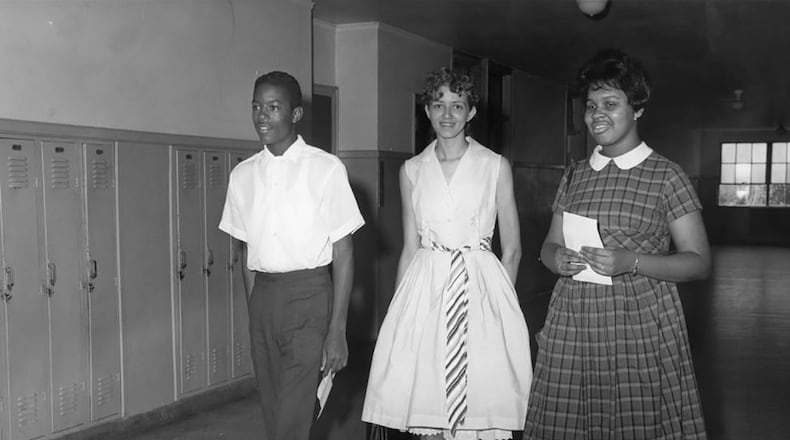On Aug. 30, 1961, the Atlanta Public School system desegregated when nine Black students—remembered as the Atlanta Nine—entered four previously all-white APS high schools. Members of the national press were in town to see whether the situation would explode into a conflict like Little Rock in 1957 or New Orleans in 1960. Here’s how the city carefully managed the potential conflict.
Above: The three students selected to integrate Brown High School walk down the hall, possibly on registration day, one day before the school integrated: Thomas Welch, who entered Brown as a junior, would eventually go on to get a master’s in city planning from MIT and would become a real estate developer in Boston. Damaris Allen, center, chose to take an early admission to Spelman at age 16 and wound up never attending Brown. Madelyn Nix, right, became a corporate attorney in Pennsylvania. Welch and Nix were on hand in 2011 for an APS ceremony honoring the Atlanta Nine. (Bill Wilson / AJC Archive at the GSU Library AJCP297-004a)
In the years after the Supreme Court’s 1954 Brown v Board of Education decision, the Georgia Legislature passed a number of laws meant to circumvent the forced integration of its schools. One 1958 law mandated that any school system that desegregated would be shut down. In 1959, the same year that this pro-segregation protest occured in front of the Governor’s Mansion, a federal judge ruled that the APS must desegregate the next year. (AP file)
Segregationist Gov. Ernest Vandiver was dealing with pressure from a statewide grassroots group of white parents called HOPE (Help Our Public Schools Inc.) who preferred integrated schools to no public schools at all. Faced with political pressure from all sides, Vandiver’s chief of staff Griffin Bell proposed a commission to study the state’s desegregation options. A pragmatic segregationist businessman from Atlanta named John Sibley would head the commission and would try to give the governor some political wiggle room. (AP file)
The Sibley Commission conducted a series of ten forums across the state for citizens to voice their concerns. One such forum took place in March 1960 at Henry Grady High School (above). Although the majority of citizen participants demanded that total segregation continue at all costs, the commission recommended that state officials comply with the federal judge’s decision and plan for orderly, if limited, school integration. Gov. Vandiver’s reluctant decision to allow integration was further bolstered after losing his fight with the federal government over integrating UGA in early 1961. (AJC Archive at the GSU Library AJCP298-020m)
Credit: William Bryan
Credit: William Bryan
Atlanta Mayor William B. Hartsfield (above left) was determined that Atlanta’s school integration would be a tightly controlled affair that would contrast with the chaos of Little Rock and New Orleans. First, APS would carefully select the black students who would integrate four high schools (middle schools and elementary schools would come later). Hartsfield wasn’t the only one preparing. Members of HOPE and the Quaker House would later arrange for the black transfer students to meet with one another and with some of their new white classmates. (AJC file)
In May of 1961, black families were allowed to apply their children to transfer to all-white schools. Ten students out of 132 applicants were selected after three rounds of tests and interviews. Above right, Annie Ruth Dennis and Irma Lee fill out their applications. (Bill Wilson / AJC Archive at the GSU Library AJCNS1961-00-01b)
Always careful to promote his city’s image, Mayor Hartsfield set up a large media press office in City Hall on the week of integration. School administrators would give visiting reporters from around the country regular updates throughout the day. Several photographers were allowed inside the four high schools to photograph the transferring students’ meetings with school principals and counselors. (Dwight Ross / AJC Archive at the GSU Library AJCP297-005l)
The reporters would converge on the city for several days. The City Hall press headquarters also had a row of teletype machines that would give them a direct line to their respective newspapers. These amenities encouraged reporters to stay at the headquarters and report the story through the city administration’s official statements and through interviews with APS officials. (Dwight Ross / AJC Archive at the GSU Library AJCP297-005k)
At each of the four schools, plainclothes officers drove unmarked vehicles to drop off the Black students. The students arrived several minutes after the main bell rang, thus avoiding the crowds. Above, students Madelyn Nix and Thomas Welch arrive at Brown High School on Aug. 30, 1961. In the afternoon, the students would leave before the rest of the school in similar vehicles. At each school, the press and curious onlookers were ordered to stay at a distance. Members of the pro-integration group HOPE cheered as soon as the students safely entered the buildings. (Horace Cort / AP file)
Willie Jean Black, Arthur Simmons and Donita Gaines leave Northside High School on the second day of class in 1961. The three were among nine Black Atlanta teens who integrated the Atlanta Public Schools that week in late August. (Charles Pugh / AJC Archive at the GSU Library AJCP297-004b)
Charlayne Hunter, above, center, was one of two black student to integrate the University of Georgia only eight months before APS integrated. In the summer leading up to the APS integration, Hunter met with the Atlanta Nine in their homes and tried to offer advice. Still a journalism student, she reported on the APS integration for the Black newspaper, Atlanta Inquirer. She is seen here talking with reporters on Aug. 30, 1961 across the street from Brown High School. (Horace Cort / AP file)
There was good cause for concern for the students’ safety. Their names were publicly known and the Ku Klux Klan distributed the students’ pictures, addresses and phone numbers. The students’ families received abusive calls and police protectively patrolled their homes. Atlanta police also patrolled the four high schools for the entire first week of school. On the week of integration, protesters were turned away and parents were asked not to visit the schools once classes started. Above, an unidentified white man, right, is placed into a patrol car at Brown High School on Aug. 30, 1961. He was released later without charge. (Horace Cort / AP file)
Despite the fact that Grady High School attracted a few protesters, it was a quiet scene as Black students Lawrence Jefferson and Mary McMullen arrived on Aug. 30, 1961. (AJC Archive at the GSU Library AJCP297-005e)
Grady High School counselor Elizabeth Setze, above, left, meets with students Lawrence Jefferson and Mary McMullen on their first day at the school. Atlanta Constitution photographers were allowed inside the four APS high schools that day but the newspaper’s archived images only show the students meeting with administrators. (Bill Wilson / AJC Archive at the GSU Library AJCP297-005a)
Student Lawrence Jefferson meets with Grady High School Principal Roger Derthick on Aug. 30, 1961. Jefferson said in 2011 that he wasn’t very worried that day. “I had lived in an area near Grady High School and actually played with some of the white students who attended Grady before the school was integrated.” (Bill Wilson / AJC Archive at the GSU Library AJCP297-005c)
Grady High School had two minor disturbances that week. On Aug. 30, a self-described “American Nazi” from Arlington, Va. attempted to picket and was arrested when he refused to leave. On both Aug. 30 and Aug. 31, a father baring a switch (pictured) arrived to whip his daughter for attending the newly integrated school against his wishes. (The Atlanta Constitution reported that his wife insisted that the daugther attend.) On both days, the father was escorted away by the police. (Hugh Stovall / AJC Archive at the GSU Library AJCP297-005d)
Students Lawrence Jefferson and Mary McMullen head back to the ride provided to them by APS at the end of their first day at Grady High School on Aug. 30, 1961. (Guy Hayes / AJC Archive at the GSU Library AJCP297-005b)
Students Martha Ann Holmes and Rosalyn Walton arrive at Murphy High School on Aug. 30, 1961. Holmes went on to graduate from Spelman and became an APS elementary school teacher. Walton became a system manager for the Internal Revenue Service. Walton (now Rosalyn Walton-Lees) was one of three Atlanta Nine students honored by the APS in a 2011 ceremony. (Bill Wilson / AJC Archive at the GSU Library AJCP297-004g)
Above left, Murphy High School counselor Maribel Richardson helps Rosalyn Walton and Martha Ann Holmes on their first day. (Bill Wilson / AJC Archive at the GSU Library AJCP297-004c)
Above right, Murphy High School Principal George M. McCord, Counselor Maribel Richardson and APS Area Superintendent G.Y. Smith check with student Rosalyn Walton during her first day at the school. (Bill Wilson / AJC Archive at the GSU Library AJCP297-005g)
Murphy High School Couselor Maribel Richardson helps Rosalyn Walton get settled into a typing class on her first day at the school. On that morning, the student council president said over the school’s adress system, “Today we have two new students at Murphy High. Let’s treat them with politeness and respect as we would any other persons.” (Bill Wilson / AJC Archive at the GSU Library AJCP297-005j)
Murphy High School saw the most significant disruption of any of the integrating schools on Aug. 30, 1961. Four DeKalb County teens were arrested for disorderly conduct after they refused an order to leave the area. One teen tried to run away but was captured. One of the teens carried a hook-bladed knife and another had a pistol and claw hammer in his car. Police also found a stack of racist literature in the car. One teen identified himself as the president of the “Knights of the Confederacy.” The teens were shown to the press in this lineup and received sentences between 30 and 60 days in jail. One day later, the judge had a change of heart an attempted to release the teens but Mayor Hartsfield refused the judge’s request. (Billy Downs / AJC Archive at the GSU Library AJCP297-005i)
Students Arthur Simmons and Donita Gaines enroll at Northside High School with the help of counselors Ralph Kemp and Mary Ballard. This photo may have been taken on Aug. 29, the day before the students’ first official day of school. Simmons and Gaines would be joined by Willie Jean Black in integrating the school. (Bill Wilson / AJC Archive at the GSU Library AJCP297-005f)
A police officer directs traffic at Northside High School on the first day of its racial integration, Aug. 30, 1961. (AJC Archive at the GSU Library AJCNS1961-08-30k)
White students at Northside High School mug for the camera on the school’s first day of racial integration, Aug. 30, 1961. (AJC Archive at the GSU Library AJCNS1961-08-30q)
A police officer standing by at Northside High School on Aug. 30, 1961 carries a relaxed expression. Two days later, Mayor Hartsfield would scale back the security measures at the four schools and the Black students would enter and leave their respective schools at the same time as the white students. (AJC Archive at the GSU Library AJCNS1961-08-30bb)
Two students speak with a police superintendent outside Northside High School on Aug. 30, 1961. The two students were from out of town and wanted to witness the events of that day, according to one of them who identified himself when seeing the photo years later. As he explained to the AJC, “We were visitors passing through the city who sympathized with the goals of integration. We still have those sympathies.” (AJC Archive at the GSU Library AJCNS1961-08-30a)
Willie Jean Black, Donita Gaines and Arthur Simmons wait to be picked up from Northside High School on the first day of racial integration, Aug. 30, 1961. Black’s comments to a reporter echoed what others of the Atlanta Nine said of their reception that day: “They were not overly friendly but they were well mannered.” According to an AJC article from 1991, Black died in a house fire in 1988. The same article reported that Gaines left Northside during the 1961-62 year to return to her former school. She said, “I felt torn, as if it was up to me to prove all Blacks were equal. That creates a lot of stress for a 16-year-old.” (AJC Archive at the GSU Library AJCNS1961-08-30o)
Willie Jean Black, Arthur Simmons and Donita Gaines leave Northside High School on the first day of its racial integration, Aug. 30, 1961. With the world watching, Atlanta managed to avoid the violence and chaos that other southern cities had encountered. That night, President John F. Kennedy praised the city’s “courage, tolerance and above all, respect for the law.” (AJC Archive at the GSU Library AJCNS1961-08-30ee)
About the Author
Keep Reading
The Latest
Featured
































